-
The Battle of Longewala was fought from 4-7th December 1971
near Jaisalmer. Here is an account of the war written from a military
perspective. Where did the Pakistanis go wrong? Learnings for all.
If there
is one battle that could have had far reaching consequences
on the final outcome of the war, politically as well as militarily - it was Battle of Longewala.
Had India lost this battle on the night
of 04 Dec/05 Dec 1971 the Pakistanis would have an easy run till Ramgarh and Jaisalmer and could have had an upper hand during negotiations? Remember what the then
President of Pakistan had said; “The defense of East Pakistan lies in the West.” The primary objective of Pakistani forces was to hold out in East Pakistan until
Pakistan gained some strategically important area in the West, which could then be used to bargain.
So, in that sense, the
soldiers who doggedly fought on ground, and those pilots from the IAF (Indian
Air Force) who relentlessly carried out air attacks and denied the enemy this
opportunity and made them run, did a fabulous job. There can never be enough
words to explain their sense of duty, their bravery, their determination and
their sacrifice and hence it needs to be retold year after year, lest it is
forgotten.
Fighting such a battle is every soldier’s
dream and it’s not often that one gets such an opportunity.
Background
The DESERTS are
conducive for mobile warfare as it allows Tanks to move unhindered. It provides
them vast expanses of waste land, which is largely flat and devoid of any
obstacle. There are very few towns/ cities and as a result there are few
connecting roads and tracks.
Deserts are, because of scare resources,
a logistician’s nightmare. Hence, even sources of water are a tactically important place because the defender may like to deny to the enemy/ attacker.
It is therefore,
natural, that there would be large gaps in the defenses as it is pointless to
hold every mile. The logic is even if the attacker moves his forces cross
country avoiding roads and tracks, he will have to still come and capture the
communication center in order to move his hundreds of logistic transport
vehicles on that road, in support of his attacking troops, otherwise, his
offensive will come to a grinding halt.
Hence roads, communication
centers and water sources become tactically important and are defended.
The communication
centers, are defended like yester year forts that were established on Hill
tops.
The infantry in
defensive role is therefore, employed for holding defenses around these
communication centers on Sand dunes and in order to enhance the defense
potential of the position, they lay extensive anti-tank mines around their
position, thereby denying the attacker a change to employ their tanks in the
assault role.
In an Offensive
operation, infantry is employed in the final assault, as the tanks cannot be
employed, due to the Anti-Tank mines all around the defensive position. As a
result, during the offensive operations, it becomes important for the infantry
and tanks to move together, which is off course difficult in deserts. Hence,
without infantry tagging alongside the armour, the tanks may become sitting
ducks. This necessity, later on gave birth to Mechanized infantry, which could
tag along with Tanks in tracked vehicles.
But in 1971, the
infantry that was immediately required for the protection of tanks and contain
enemy was carried on the tank turret, the rest could follow on the trucks, once
the track is laid by Engineers as normal trucks cannot keep pace with the tanks
in deserts and may get stuck in sand or it may walk cross country. The latter
option is ostensibly time consuming and risky in a plain country.
Thus, in an offensive operation in
plains/ deserts the tanks are employed, to move rapidly as deep as possible into enemy’s area, exploiting those large gaps in defenses, bye passing minor positions and
surround/ isolate those major forts i.e. the communication centers in depth with the help of infantry which is carried on the tanks and later on capture them, with the
help of follow up infantry.
In all the wars that
we fought with Pakistan 1947-48, 1965, nothing noticeable happened in the deserts.
There was a general belief on both sides that major operations were not
feasible in Rajasthan and Sindh deserts. And hence it was thinly held.
Consequently, Pakistan had 18 Infantry division deployed opposite us, defending
strategically important town of Rahim Yar Khan. We had 12 Infantry division
defending an area north of Jaisalmer of more than 200 kms frontage. In deserts,
it is normal, because of the peculiar nature of terrain, as described above.
Rahimyar Khan is an important
communication center and a major city of Pakistan’s Punjab province, located opposite the Indian 12 Infantry division and is much closer to the border than Jaisalmer
is. These days, Rahimyar Khan is part of the green belt. What Sri Ganganagar is to India, Rahim yar khan is to Pakistan! However, things were not like this in
1971.
The main thrust of the
Indian Army during the 1971 WAR was directed towards the Eastern theatre
(East Pakistan), while in the Western sector the primary aim was to prevent the
Pakistan Army from achieving any success that they could use in post-war
negotiations.
Scenario on the eve of war
The planning for war
had commenced much before 03 Dec 1971, when Pakistani fighter aircrafts carried
out an air attack in the evening. So, it was already planned that in the event
of hostilities, the Indian 12 Infantry division, leaving its minimum troops in
defensive role, would launch bulk of its force from area
Sadhewala-Tanot-Kishangarh to capture Rahimyar Khan, which would disrupt
rail-road link from Lahore to Karachi.
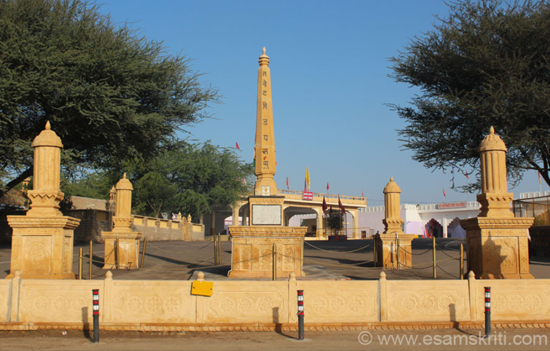 Victory Tower at Tanot. Behind is Tanot Temple.
Victory Tower at Tanot. Behind is Tanot Temple.
This Division was concentrated
further East at Tanot, preparing for a thrust. However, when the units of 12 Inf Division started receiving new vehicles, new equipment and the troops moved
from their peace locations to Tanot etc, the intentions of 12 Infantry Division became evident to the Pakistan army, like the Indian army came to know about the
Pakistan army’s intentions in Siachen because both the armies were buying high altitude winter clothing and other items for High Altitude from almost the same
vendors.
Indian army commanders
believed that large scale military operations were not feasible in the
Rajasthan desert so there would be no significant opposition.
The Pakistani’s side also worked on
similar assumptions and also expected that since the Jaisalmer air base had not been activated there will be hardly any threat from the air.
The Plan
The
Pakistan army commanders, in pursuance of the Policy ; The Defense of East lies
in West
, decided to launch a
pre-emptive strike to not only blunt Indian attack on Rahimyar Khan but also to
capture strategically important towns, by carrying out a bold and swift
armour-infantry thrust through the Reti-Longewala-Ramgarh-Jaisalmer axis,
thereby exploiting the large gaps in defenses. The chances of success, they assumed,
were high as the bulk of Indian infantry division was concentrated East of
Tanot for the impending attack at Rahim Yar Khan.
Their objective was to capture
Ramgarh and Jaisalmer, which were almost 30 and 100kms from the International Border.
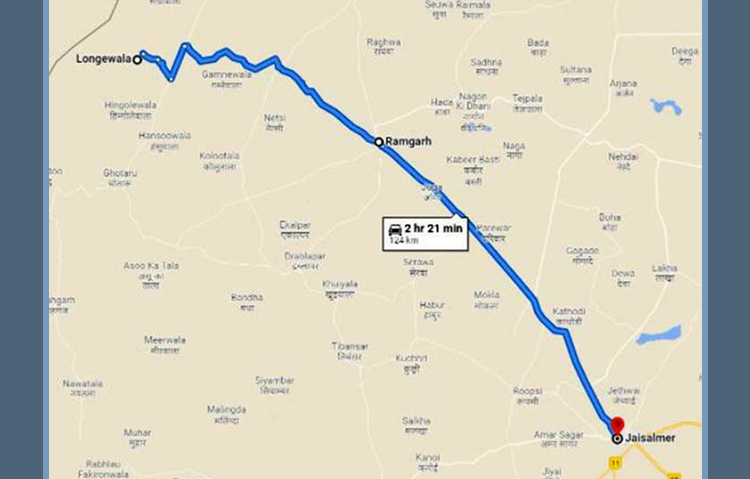 Longewala to Jaisalmer.
Longewala to Jaisalmer.
The tarmac road
connecting Longewal to Ramgarh and then to Jaisalmer was of vital importance
for the enemy to move their logistic transport, Fuel for tanks, Artillery
ammunition, and Big Guns, to support the tanks and infantry that intended to
capture Jaisalmer and Ramgarh.
So, whilst the tanks could
move cross country over the sand dunes the logistics to support the tanks in Ramgarh
and Jaisalmer needed wheeled trucks which need a road.
However,
the area between the international border and Longewala and further towards
Sadhewalla was a high-density sand dune area.
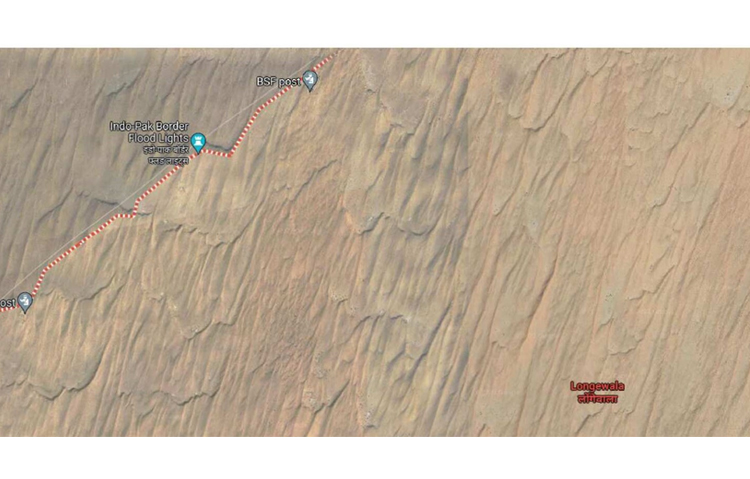 Indo-Pak
Border Floodlights.
Indo-Pak
Border Floodlights.
The Indian army commanders had ruled out the possibility of any major
armour threat originating from this sector
. T
his view has prevailed even till the 80s, when
the author had an opportunity to serve there.
The sand dunes in this
area are of loose sand and huge with steep gradients thereby making it
difficult for even tanks, known for their cross-country mobility, to maneuver
around these slippery sand dunes.
So, although,
Longewala was barely 12-15 kms from the border and had a connecting tarmac road
to Ramgarh, the possibility of any major tank threat originating from this sector
was ruled out. .
During peace time it
was guarded by a BSF company.
So, ostensibly, it was
an excellent but an audacious plan to out flank the Indian Defenses and take
the Indian army by surprise.
Pakistan Plan
Employ one armored
regiment with an infantry battalion to capture Ramgarh and another armoured
regiment with an Infantry battalion to move to Jaisalmer and capture it.
Initially, the plan
was to bye-pass Longewala but subsequently realising its importance, they
decided that it should be isolated and captured by 206 Infantry Brigade less a
Battalion which would follow the advance and capture Longewala and establish a
firm base.
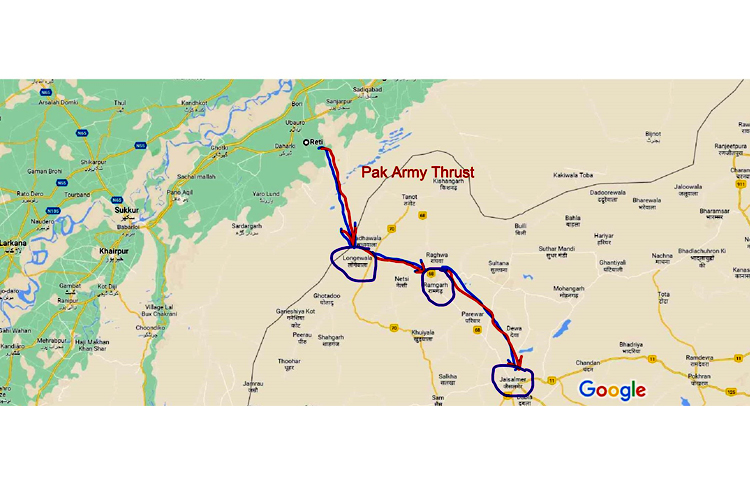
Situation on Indian side at Longewala
Just prior to the war in 1971, as is the
practice even now, the defences were reorganised and so the Longewala post was vacated by the BSF and occupied by “A” Company of 23 Punjab (about 120 soldiers) led by
its Company Commander Major (later Brigadier) Kuldip Singh Chandpuri. The rest of the Battalion was moved to Sadhewala to eliminate a Pakistani border outpost, so as
to facilitate the main attack of the 12 Infantry Division for the capture of Rahimyar Khan.
As the BSF was
occupying Longewala as a Border Out Post, its defences were not well developed.
There were no obstacles ahead of the Defences; No mines and no barbed wire.
However, the Post was located on a Dominating Sand Dune.
There was,
fortunately, a single strand of wire that was strung around the post by the BSF
to deter their camels from straying. This wire later helped the Indian troops
immensely as the Pakistanis seeing this wire, believed that a minefield existed
around the post.
The company of 23
Punjab in addition to its integral small arms, had two medium machine guns and
two 81 mm mortars.
The Longewala post
also had a battery of the 170th Field Regiment in Direct Support that was
located at Saddhewala.
As regards the Airforce
, a training flight of
four Hunter fighters was moved from Jamnagar to Jaisalmer and formed into an ad-hoc
squadron. Wing Commander (later Air Marshal) MS Bawa was the base commander.
The primary role of this ad hoc arrangement was air defense. Allotment for
offensive air support was never envisaged even for the attack planned by Indian
army for the capture of Rahim Yar Khan. So, both sides were convinced that
there will not be any air opposition and so had not planned for it in their
operations.
Consequently, Pakistan
army decided to undertake this audacious operation without air support
including ground air defense of their own.
As the Indian attack could not go beyond
its launch pad but Pakistan’s plan did, they paid dearly for overlooking this important aspect.
The Action Commences
Pakistan started the
war on the evening of 3 December, 1971.
And soon thereafter,
Company Commander Maj Kuldip Singh Chandpuri sent a strong patrol of a Platoon
strength to the International Border under Lt Dharam Vir Singh.
On 4 December evening, this patrol which
was near the IB, heard sounds of tanks on Pakistan’s side and so he immediately informed his company commander. Obviously, no one would have believed this information
so the CO of 23 Punjab must have asked him to confirm it as no one in its wildest of dreams could have imagined a major tank threat from this sector. But when the
patrol leader assured them, that he could see the dust and roar of hundreds of tanks as they neared the IB, Maj Kuldip Singh must have raised his voice and CO, would
have thumped the table of the Brigade Commander. Kudos to the Commanding Officer of 23 Punjab Lt Col Khursheed Hussain who finally prevailed over the Brigade Commander
to send an Air OP , under Maj Atma Singh, who observed from air hundreds of Pakistani tanks moving towards the IB.
However, it was still
too early to take a decision and work out the precise objective of these enemy
tanks. Because, attack on Longewala for Indian Commanders was still a distinct
possibility.
Meanwhile, as it
turned dark, the Patrol Leader Lt Dharam Vir could now observe in front of him
a large force of tanks and infantry crossing the border. He stealthily shadowed
the enemy force using the cover of sand dunes. He could now construe that this
large force of tanks was heading towards Longewala. He continued to inform his
company commander who in turn must have kept the CO informed.
The CO was now caught in a precarious
situation. He was in no position to take a unilateral decision and send reinforcements to Longewala as his Battalion was poised for a different task; Capture of
Pakistani BOP, which was part of the Division task. Any unilateral decision would jeopardize the Division’s operational plan and sending reinforcements to Longewala
could have only been possible with the concurrence of higher ups; Brigade Commander/GOC. Moreover, sending reinforcements to Longewala was a race against time. If the
reinforcements that would be vehicle bound do not reach on time they would find themselves in a precarious situation. Moreover, there were no tanks available with the
formation that could match Pakis Pattons. It must have been a Catch 22 situation for the Commanding Officer.
However, the CO, 23
Punjab, Lt Col Khursheed Hussain decided to send the two RCLs, (Recoilless), Anti
tank Jeep mounted guns to Longewala to support the beleaguered company. He must
have surely kept his fingers crossed till they reached Longewala.
By now Major Kuldip
Singh realized the enormity of the task as he was facing an enemy many times
more in numbers; atleast 45 tanks and 1000 infantry men. He had hardly any
choice left, with tanks just approaching him, he could not with his 120 men
attempted a planned withdrawal on foot and that too in a desert.
Had he taken this
approach, he and his troops would have been massacred by the enemy tanks as the
tanks would have caught them in an absolutely indefensible position. So, he had
only one choice; FIGHT.
Reportedly, Maj
Chandpuri was given this choice of a tactical withdrawal. But, realizing the
dangers of this withdrawal in deserts against tanks, he opted to fight it out.
Fortunately, as part
of Engineer stores, he had anti tank mines which could not be laid due to
paucity of time, as his company had just taken over the defenses from BSF.
Hence, he ordered his men to throw those mines ahead in front of the defenses.
There was no time available to lay those mines properly. Some of them were
thrown even without arming them, implying that they would not have blasted even
if the tank had passed over them.
Meanwhile, the
artillery battery which was in direct support of the Unit started bringing down
fire on the enemy but that was not very accurate as there was no Arty OP posted
with the company.
By mid-night the enemy
tanks closed in to the defenses at Longewala and brought down fire on the
Company defenses. Pakistani medium artillery also opened up from across the
border with, killing five of the ten camels from the BSF detachment.
Miracles!
Napoleon had once remarked; “Ability
is of little value without opportunity, I had rather my generals be lucky than able.”
So, as the column of
enemy tanks neared the post, the tanks halted when they saw that strand of
wire, the same one, which the BSF had strung around, in order to prevent its
camels from straying into open desert. As the minefields are always marked by a
barbed wire so as to prevent own troops straying into it, the enemy tank men
construed that this is an anti-tank minefield, So they stopped.
The enemy was not
envisaging any worthwhile opposition so they were surprised by the minefield
and in order to confirm they switched on the Headlights of the tanks. And to
their surprise they could see the anti tank mines lying in open. Naturally, a
thought must have occurred in their minds; if there are so many in open , as to
how many would be buried under the earth.
Hence, the enemy tanks
who had intended to overrun the BOP at Longewala came to an abrupt halt and
waited for their infantry to launch an assault.
However at night, with
heavy accurate fire coming from Longewala company defenses from an elevated
position, it was not easy for the infantry battalion whose troops have been
carried on a tank turret for 20 kms to gather their wits and reorganize so
early to attack the defenses.
Meanwhile, another out of the ordinary happened that night.
The two RCL Jeeps that
were sent to the beleaguered company by the CO, drove through the enemy tanks
with head lights blazing and entered the company defenses past mid night. Hats
off to the courage and ingenuity of those men driving the Jeeps and the RCL
Commander.
This bolstered the anti-tank capability
of the beleaguered company. The RCL guns knocked down a few tanks and that caused the extra fuel barrel loaded on tanks for the march ahead also caught fire. This made
the task of Maj Kuldip Singh further easy as the whole battle field on the enemy side was now illuminated and his MMGs and RCLs could now bring down accurate fire on
enemy’s infantry as well as tanks which was trying to form up for the attack.
This fire also created
a dense smoke screen that added to confusion in the enemy lines and further
delayed their assault.
The RCLs proved quite
effective because they could hit at the thinner top armour of the Pakistani
tanks from their elevated defensive position. They destroyed 12 tanks.
Although massively outnumbering the
Indian defenders and having surrounded the Indian company of barely 100 odd men, the Pakistani troops were unable to advance over open terrain on a full-moon night.
This speaks volumes about the grit and determination of an INFANTRY COMPANY–ALPHA COMPANY OF 23 PUNJAB.
By the time the
Engineers of Pakistan Army came and could ascertain under heavy fire that this
was no mine field it was already morning.
The Action from Air
By then Wing Cdr Bajwa
was ready with his hunters and waiting desperately for the first light at the
Jaisalmer air field. As soon as the first sun rays lightened up the sky, the
Hunters took off from Jaisalmer air field and made a mincemeat of enemy tanks.
The tanks without any air cover from their air force and any worthwhile air
defense of their own were like sitting ducks.
The IAF Hunters flew
sorties after sorties, they were only four but they refueled, rearmed and
returned at such regularity that Pakistani tanks and trucks following them had
no respite throughout the day. The tanks without the air defense ran
around in circles to lift the dust so as to create a screen but it did not help
them much in day time.
The enemy tried to
marshal the troops and tanks for assault on the Post even during the day but
the Hunters made sure that the Pakistanis do not succeed in this endeavor.
The Pakistanis because
of the relentless action by the IAF Hunters left their tanks and vehicles stuck
in loose sand and ran back to their side of International Border.
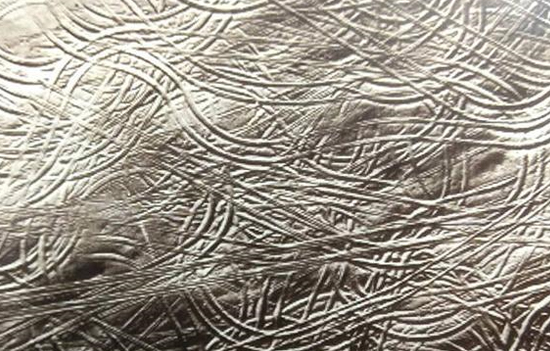 Pic tells story
as to how Pakistani tanks circled around to evade air attack.
Pic tells story
as to how Pakistani tanks circled around to evade air attack.
A Pakistani Radio message intercepted on 05 Dec says it all;
“The enemy air force has been creating
havoc. One aircraft leaves, and another comes and stays overhead for twenty minutes. Forty per cent troops and tanks have been destroyed, injured or damaged. Further
advance has become very difficult. Send Air Force for help as soon as possible otherwise even a safe withdrawal would be difficult.”
Why did Pakistan Lose?
When I was attending
the Staff course at DSSC Wellington, one of my course mates a Bangladeshi
officer during a light hearted conversation after a Sand model discussion
boasted that he is the only one here who has attended staff course with all our
adversaries ; The Chinese as well as the Pakistan army. When I asked him about
the difference he experienced. He remarked;
“The curriculum is by and large the same
in Pakistan Staff College and Chinese Staff College but the Pakistan army encourages its officers to be unconventional in their plans, whereas, your training staff in
India is very conventional in its approach, it discourages to be unconventional”.
His statement reminded
me of Longewala Battle. Ostensibly, Pakistan has launched some very bold
operations and has taken us by surprise in 1947, 1965, 1971 and even at Kargil.
But each time it lost
because it overlooked some basic aspects-
1.
A plan can be audacious and bold but the same can be executed
with the similar audacity by the troops only when they have the where with all
to execute that plan.
They forgot the principle that the armed
forces learnt in WW II; One who controls the sky controls the ground beneath.
Consequently, they did
not cater for any air support for its ground forces and as a result barely four
hunters could play merry hell with their ground troops. Pakistan lost over 200
soldiers, 34 tanks, and hundreds of armoured vehicles and trucks. On the Indian
side, only 2 men were killed.
Bravo. The plan may
sound exciting but to make infantry march 200 kms prior to the FINAL ASSAULT is
not an audacious but a stupid plan. In order to achieve surprise the Pakistanis
ordered an approach march to the IB from its concentration area South of Reti
on the night of 03 December so that they would thereafter cross IB on the night
04 December, and then continue moving towards Ramgarh and Jaisalmer. This is
almost an impossible march of 200 kms in the desert. So, by the early hours of
4 December they were still almost 30 kms away from IB.
No wonder, the
exhausted troops could not launch a coordinated attack on any of these
objectives given to them. They marched Hundred Km and got rogered.
2. Undermining the
audacity of the Indian troops is one big blunder Pakis have been committing again and again. Perhaps this myth of Islamic superiority has gone too deep into their
veins.
3. It is not understood
why the armoured column that was tasked to move to Ramgarh and capture Ramgarh, bye passing Longewala, did not continue its advance and got involved at
Longewala.
May be, the commander
of that Task force was a bit reluctant to move ahead without Longewala being
secured. He might have felt that his troops, after reaching Ramgarh, would be
placed in a dangerous situation i.e. without their rear being protected.
4. Moreover, it’s easy
to order Infantry to be piggy bagged on tanks but at night to launch a coordinated attack immediately after experiencing the shocks and jerks while travelling on the
turret of a tank for 20 odd kms is a daunting task, more so in deserts where some of them might have lost their orientation.
Perhaps, that’s what happened with the
Baluch Battalion whose troops were carried on the turret till Longewala.
5. The objectives and
troops assigned to achieve those near impossible objectives were changed many a times by the Pakistanis which resulted in chaos, confusion and low morale. For
instance;
“On 04 December, GOC 18 Infantry Division
on a representation from Commander 206 Infantry Brigade, that the tanks of 38 Cavalry were mechanically unsound the Divisional Commander gave the task to neutralise
Jaisalmer airfield to 28 Baluch (Recce and Support Battalion of 18 Division less company, with two additional companies from 206 Infantry Brigade). Later at the
suggestion of Commander 51 Infantry Brigade the mission to Jaisalmer was abandoned.”
“At about 0900 hrs one squadron of 22
Cavalry and two companies of 38 Baluch had again formed up to attack but the Brigade Commander came over and called it off”.
6.
The enemy, in their haste and over confidence, allowed their
armour to overshoot the Infantry and also did not allocate enough air resources
for their thrust to Longewala.
As a result, once they
hit the assumed minefield the whole operation got stuck in the loose sand of
Longewala.
Conclusion
Yes, the claim by
Pakistani army that they halted Indian Army attack and saved capture of Rahim
Yar Khan can be accepted with a pinch of salt.
Secondly, is it not surprising that Maj
Kuldip Singh Chandpuri’s company had only two casualties despite being heavily outnumbered numerically and in terms of quality of equipment. The Pakistanis had Chinese
tanks and US Pattons, where as we had none. This puts the enemy’s fighting capabilities in doubt.
The enemy although surrounded the post
but could kill only two, implying they were never able to bring down effective fire on the Company defenses. Even the enemy’s Medium artillery might have been
inaccurate.
Bravo. Perhaps their
morale was low or they lacked faith in the ambitious plan of their senior
commanders and hence did not fight to their fullest potential. As a result, the
moment they saw the strand of wire the tanks halted and infantry that was
purposely carried on tank turret, took hours to reorganize and failed to launch
even a single coordinated attack on a full moon light. The tanks halted instead
of bye passing Longewala and moving on towards their assigned objective;
Ramgarh, is an indicator that there was something more than what meets the
eye.
It was an excellent
plan that surprised the Indian army but could not be executed with the same
flair by the Pakistani troops.
 Memorial at Longewala in honour of 23 Punjab.
Memorial at Longewala in honour of 23 Punjab.
So, there is a lesson
for all;
You can send the
troops to a battle field but cannot make them fight.
Just a caution here,
we may have to face similar challenges with the AGNIVEERS. In next 10 years,
bulk of Indian army will comprise of Four Year Contract; AGNIVEERS.
In the battle of skill
over technology and brain over brawn, the former has always prevailed and the
most recent examples of this is Wing Commander Abhinandan Varthaman, manning a
MiG-21 Bison, who shot down a much more technologically advanced F-16 in a
dogfight.
After the Kargil war
Gen Malik, the then Chief of Army while explaining the cause of Pakistani
defeat, also said the same;
“The Pakistanis have always primarily
relied on their equipment, which has led to their downfall on each occasion. We have beaten them time and again not due to weapons but by exemplary leadership and
innovative battleground thinking of our men.”
In view of the above,
this age old dictum still holds good;
“It`s not the machine but the man behind
the machine that counts” And the Longewala battle bears testimony to this.
Last but not the least, this victory on 05th Dec,
right in the initial days of the war must have boosted the morale of the whole
Nation , leave aside the armed forces. If for Pakistan the defense of East lied
in West, for India the Victory on the West assured Victory in the East
too.
Author Col N Bhatnagar (veteran)
is an alumnus of
NDA, Prestigious Def Services Staff College and XLRI, Jamshedpur. He served in
Indian army as an Infantry Officer in all parts of the country and also in Sri
Lanka and has also worked with Reputed Companies-Power, Hospitality and Health
Care sector. He has also worked as a National Assessor of CII for its CII-EXIM
Bank Award and authored three Books.
Also read by author
How
Srinagar was saved in 1947
To read
all articles by author
To
buy book books by author
Battle pictures and maps provided by
author. Others by Sanjeev Nayyar. Purpose of writing is self-less sharing.